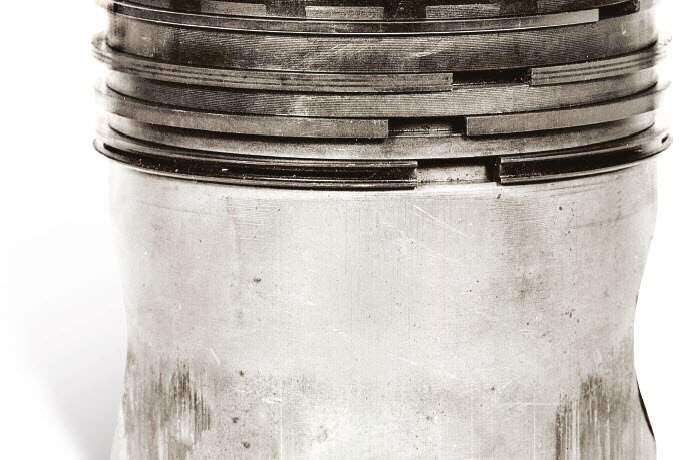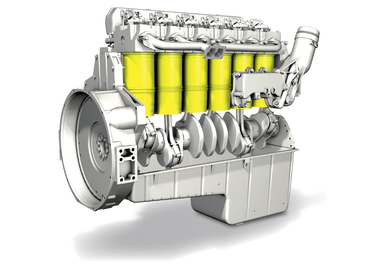
Seizure due to insufficient clearance on the piston skirt
Information on diagnostics
What do we mean when we talk about seizure caused by a lack of clearance? What causes dry running between the pistons and the cylinders? What causes seizure on parts of the piston skirt? Why is the piston pin discoloured blue? And how do the thrust and anti-thrust points appear on the bottom of the piston skirt? This article gives you detailed answers.
Seizure due to insufficient clearance on the piston skirt
- Several similar areas of seizure marks around the piston skirt.
- Seizure marks on both the pressure and anti-thrust sides of the piston skirt, i.e. seizure marks on opposite sides.
- Surface changes from bright wear marks to smooth, darkly discoloured areas of wear caused by rubbing.
- Undamaged ring zone.
Damage assessment
The clearance between the piston skirt and the cylinder running surface was either too narrow by design, or it was restricted by distortion that possibly did not occur until the engine was operating.
 |
Note: In contrast to a seizure due to lack of lubrication, a seizure due to insufficient clearance always occurs after a brief running-in period following engine reconditioning. |
Possible causes for the damage
- Cylinder bore too small.
- Cylinder head over-tightened or tightened unevenly (cylinder distortion).
- Uneven mating surfaces on the cylinder block or cylinder head.
- Dirty or damaged threaded bores or cylinder head bolts.
- Seized or insufficiently lubricated seating surfaces.
- Use of incorrect or unsuitable cylinder head gaskets.
- Cylinder distortion caused by uneven heating due to lime deposits, dirt or other malfunctions in the cooling system.
45° seizure marks
- Seizure marks on both the pressure and anti-thrust sides, offset at approximately 45° to the piston pin axis.
- The seizures areas change from bright wear marks to relatively smooth, darkly discoloured areas of wear caused by rubbing (Fig. 1).
- Piston pin displays blue tempering colour (Fig. 3). Reason: piston pin bed has become hot due to insufficient clearance or a lack of oil.
Damage assessment
The piston pin boss has heated up excessively. The thin-walled and elastic piston skirt is able to compensate for the increased thermal expansion on the pressure and anti-thrust sides. The piston pin boss is stiffer and its expansion increases. The clearances are restricted and a piston seizure occurs. The piston seizure is centred around the transition between the piston pin boss and the piston skirt.
Possible causes for the damage
- Mechanical overload of the connecting rod bearing, e.g. due to abnormal combustion.
- Malfunction/fracture in the oil injection jet.
- Insufficient or no oil pump pressure.
- Insufficient lubrication when the engine was first taken into operation. The piston pin was not or was insufficiently lubricated when it was assembled.
- Failure of the connecting rod bush (piston pin seizure) due to insufficient clearance or lubrication.
- Installation fault during the process of shrinking the piston pin (shrink-fit connecting rod). During the shrinking process, care must be taken to ensure that, immediately after the piston pin has been inserted, the piston pin bed is not checked for freedom of movement by tilting the piston back and forth. The temperatures are equalized between the two components immediately after the cool piston pin is inserted into the hot connecting rod. The heat introduction increases the thermal expansion of the piston pin as is the case during engine operation. If the bed is moved in this state, it can cause initial rubbing marks or seizure marks. This may cause stiffness or failure of the piston pin bed during engine operation. For this reason, allow the assembled components to cool down before checking the freedom of movement.
Seizure due to insufficient clearance at the bottom skirt end
- Seizure due to insufficient clearance at the bottom skirt ends, with wear marks and counter-wear marks.
- The marks change from bright wear marks to smooth, darkly discoloured areas of wear caused by rubbing (Fig. 1).
- There is nothing unusual about any of the remaining parts of the piston.
- Seizure marks in the cylinder liner in the area around the lower O-rings (Fig. 2).
Damage assessment
The piston seizure at the bottom edge of the piston skirt was caused by distortion/ restricted clearances in the lower area of the cylinder liner.
Possible causes for the damage
- Incorrect sealing rings: excessively thick sealing rings can distort a cylinder liner and reduce the piston running clearance.
- Additional use of liquid sealants in the sealing ring groove. In order to seal the surfaces, the sealing rings must be able to deform elastically. The free space required for this in the groove must not be filled with additional sealant.
- Any sealing ring residue or dirt in the sealing ring grooves was not removed prior to installation.
- If the sealing rings twist when the cylinder liner is being inserted or slip out of the sealing ring groove, the cylinder liner will become constricted in this area. To prevent this, lubricant must always be used when installing the cylinder liner.
